#pathfinder artifact
Text
Astonishing Artifacts: The Book of the Damned
Sources: Pathfinder Player Companion on artifacts & the book of the damned.
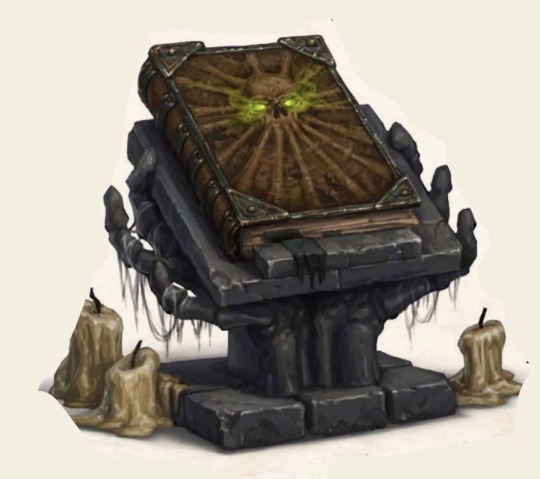
Image source: Pathfinder Campaign setting, Artifacts & Legends, pg. 15.
“Held between covers of bladed steel, stretched human flesh, and compressed ashes, this massive collection of loose folios, leathery scrolls, and gory manuscripts is the authoritative volume on unspeakable topics and evils for which there are no names.”
The Book of The Damned is the total sum of all profane knowledge and evil lore in the multiverse. It defies all logic, being possessed of more information than any tome of its size should be able to hold. It contains numerous different topics divided into different sections, which are rarely found all together. Should all chapters of this foul book be combined, its malicious intelligence awakens.
When fully combined, The Book of The Damned radiated dark energy in a large area, and evil creatures across the planes become aware of its location and desire to have it. Any good-aligned being that dares to touch it risks being slain immediately, and any being that uses this book is damned immediately.
Dark Talisman. The Book can be attuned to a powerful evil owner, allowing them to cast dark spells they shouldn’t normally have access to, and giving them insight to the workings of evil in the multiverse.
Reference of Evil. The Book of the Damned can be used to learn the dark secrets of reality, but the Book is written in a combination of languages and codes which can take up to a month to fully decipher. After an owner spends the time to understand this maddening tome, they can consult it to answer any obscene question regarding any dark topic of the multiverse.
Accursed Archive. An owner of the Book of The Damned can cause it to fold into itself, opening a horrific wound in reality that acts as a portal to a perverse demiplane. Visitors to this space find themselves in an unnerving library filled with infinite records of every evil deed in the multiverse. These articles are constantly being written, with the Book’s evil consciousness always compiling new lore. Not even the gods know the full breadth of this space, and it is curated by strange manifestation’s of the Book’s will.
The History & Legend of the Book of The Damned:
The Book’s history begins with the legendary angel Tabris. He was charged by Heaven to catalogue all knowledge in the multiverse, and appointed an army of lesser angels to aid in this task.
After spending eons chronicling all knowledge regarding the topics of good, law, chaos, and neutrality, he led his army to descend into the Lower Planes to take on the daunting task of cataloguing all evil in reality.
Tabris and his scholars never returned. His heavenly siblings mourned the loss of him and the knowledge he sought, but presumed him dead.
Unless killed, most good-aligned outsiders are ageless. Even in the timespan of celestials, Tabris was gone far too long in the Planes of Perdition for survival to be a possibility.
Despite this, He emerged from the maelstrom and returned to heaven broken and bearing the original manuscript of The Book of The Damned.
At first rejoicing his discoveries and return, the hosts of Heaven were appalled upon looking into his research. Tabris had faced pure and absolute evil, and unflinchingly recorded every ounce of it. In the eons he was away, he’d interviewed with the most horrific monstrosities of the multiverse.

Image source: Book of The Damned, pg. 255
The judges of Heaven criticized his work harshly. He had catalogued the machinations of fiends spanning timelines, sins without name, and infinite blasphemies with unflinching accuracy. He’d even sacrificed a piece of his soul and placed it within the Book, to constantly update the tome whenever a new evil occurred.
Tabris was not ashamed of his work, as he was convinced he’d successfully accomplished his task. In his confidence, the Celestials saw corruption. He was stripped of his heavenly power, barred from the planes of good, and cast out for his actions.
Before Heaven could destroy the horrid tome, it was scattered. It’s endless chapters on different subjects split apart into a multitude of dark spellbooks and horrific artifacts, each seeking to be reconnected with the other pieces throughout the multiverse.
Ramifications:
Damnation. All owners and users of The Book of The Damned have their souls Damned to one of the lower planes upon their death. Which plane of perdition they are sent to depends on their actions and what they do with the knowledge gleaned from the Book, and this damnation can only be stopped with direct divine intervention.
Fiendish Plans. Every fiend in the multiverse would do unspeakable things for a glimpse into this horrid book. Evil demigods and archfiends of all varieties constantly have agents out in the planes searching for chapters of the Book, and should one assemble it, they’d be given a supreme advantage over their peers and rivals. There aren’t words to describe what one of these beings would do to take control of the full Book.
Blasphemous Lore. The Book of The Damned is not pursued only by fiends. Celestials across the planes hunt down this Book and it’s readers, hoping to prevent its foul knowledge from spreading.
Beyond the Book:
One of the most famous aspects of the Book is the Demi plane concealed within its pages. Once an owner attunes to this artifact, they can open a doorway inside the Book.
This plane appears as a dark, vast library filled with a miasma of fog. Within this library, vast layers of bone-white stone supports shelves made of dark crystal. Each of these shelves hold tablets, books, and manuscripts on all manner of profane lore.
When touched, these articles explode into diagrams, visions, and voices detailing all the collected knowledge held within the Book. In reality, the physical book just serves as a window, each page connected to the demiplane to reveal dark knowledge. Each shelf has a topic, and all topics are organized perfectly, although this organization can be difficult for mortals to comprehend.
At the center of the plane is the largest crystalline tablet, which contains just a single piece of paper with a forbidden tune written upon it. From here, a path leads to the heart of the plane, known as the Unspeakable Word.
The unspeakable word could be considered to be the last page of The Book of The Damned, the record of Tabriz’ ultimate sin— Cataloguing every evil in the multiverse. It appears as a massive, diseased heart bound in crystal chains. Through this organ, every single evil thought in the multiverse flows through to the Book, and is recorded unflinchingly.
Knowledge of the Damned:
The longer an owner deciphers the Book or researches within the demiplane, the more foul knowledge is revealed to them. Many risk madness or destruction just by looking into the book, and very few actually succeed at finding the knowledge they search for. Over time, their discoveries gradually reveal more and more dark information about reality.
The book takes as much as it reveals, though. Whenever a being learns new information from the book, it will attempt to corrupt them. The more profane the knowledge, the more the Book twists it’s reader towards evil.
Some topics held within The Book of The Damned are:
Historical accounts of villains and atrocities committed on different worlds. This information causes a being to become cruel and insulting.
Truths regarding conspiracies and mysteries around the multiverse. This information causes the reader to feel a weight within their mind as the Book presses its influence into them.
Details about ancient dooms and prophecies, and information about ecologies of evil species. This information drains the reader’s intelligence, filling their mind with darkness.
Cryptic reports regarding evil forces in the multiverse, such as the histories of archfiends, details on cosmic horrors, and studies into the natures of fiends. This information convinces the reader of blasphemous connections, twisting their alignment towards evil.
Detailed maps and overviews of evil planes, in addition to foul rituals and spells for the manipulation and binding of fiends, along with the locations of planar portals and evil artifacts. This information enchants the reader, forcing them to continue researching as a perverse fascination develops.
Details regarding evil sites throughout the multiverse, and detailed biographies of great villains. There are instructions on how to destroy good artifacts, or profound revelations in dark magic. The researcher’s imagination is tainted by this knowledge, causing them to crave even more knowledge and power for themselves.
Maps to even more forbidden knowledge and artifacts, and hidden information about most fiends such as true names or origins. This information haunts the reader, causing them to be attacked and drained by the evil spirits trapped within the book.
Secret biographies of evil demigods, specific information regarding the Great Old Ones, and specific accounting of every evil item, deed, and event in the multiverse. Any researcher who reaches this point is already pushed past redemption, and is turned completely towards evil and damnation.
Secrets even the gods don’t know. Divine failures, primeval knowledge, and the truth of evil beyond reckoning. Just as a researcher culminates their pursuit of knowledge, the Book manifests before them and demands servitude. If the researcher refuses, they must escape or be annihilated.
The Keeper of the Book:
There are no fiends or entities native to the Book’s Demiplane. There is only one being, known as the Voice of The Damned.
Tabris himself realized that his task was near-impossible— any book, regardless of its size, would automatically become outdated if it recorded all evil in the multiverse. To combat this, Tabris locked away a fragment of himself in the book, in order to record all forbidden knowledge for eternity.
This act of corrupting a piece of himself to complete his charge ensured his exile, but also determined that the Book would always have a hidden caretaker. In the eons since Its creation, the Voice has only become ever more powerful and obsessed with forbidden knowledge.
The Voice of The Damned is bound to the demiplane within the Book, and serves as the Book of The Damned’s consciousness. It knows every single piece of information held within, and is devoted to spreading the dark information it possesses throughout the multiverse.

Image source: The Book of The Damned, pg. 171.
Ideas for using the Book of The Damned in a Campaign:
The chapters of the Book can always serve as good McGuffins, whether the players are searching for specific lore or are trying to collect the pieces of the Book.
A powerful Fiend offers the Party a massive reward for every chapter of the Book of The Damned they bring back to it. Little do they know, the Fiend intends to trap the party in the Book’s Demiplane, trying to force them to research for it so it doesn’t risk anything.
The party is facing an ancient and obscure evil, and the Book of The Damned seems to be the only way to learn how to defeat it.
A Celestial tasks the Party with attempting to destroy the Book of the Damned, piece by piece. Unfortunately, each chapter of the Book has its own unique form of destruction, and they must all be performed quickly or else the Book will simply reform itself.
The Antagonist has gotten ahold of the Book of The Damned, and is currently holed up in the demiplane to research. The party must find the portal and infiltrate the demiplane in order to defeat the Antagonist.
The Book Of The Damned served as a repository of all evil knowledge in the multiverse. It can either be a very useful tool, or a terrifying weapon, all depending on its current owner.
I have never been in the presence of more than one Chapter from the Book, but I know that when they find eachother, they fuse together and become slightly more powerful. Once the book is completely formed, its malicious intelligence will awaken and seek an owner to spread its corruption with.
The only chapter I’ve had the opportunity to read was an obscure manuscript regarding how the Book constantly seeks out new information. As far as I know, I’ve had no Ill-effects, showing that not all of the knowledge this book holds is capable of corrupting the reader.
Yes, I am now a Warlock devoted to cataloguing knowledge. There is no relation.
- A Weird Warlock.
#wowieweirdwarlock#pathfinder#pathfinder lore#the book of the damned#pathfinder artifact#it took me so long#:.(#WWW: Astonishing Artifacts
4 notes
·
View notes
Photo
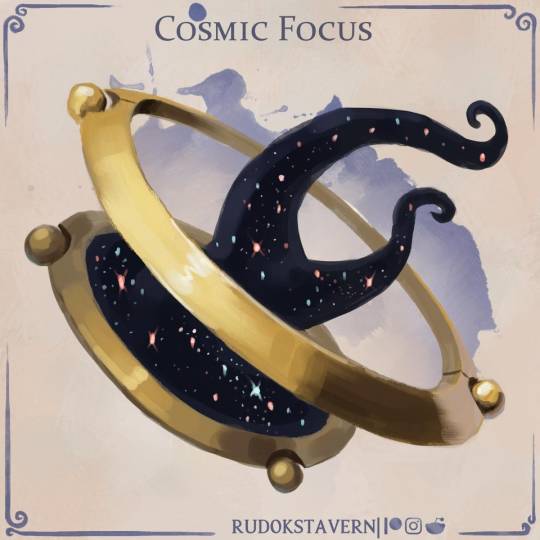
[X]
Check out Tabletop Gaming Resources for more art, tips, and tools for your game!
#wondrous items#relic#artifact#tabletop rpg#rpg#tabletop gaming#pen & paper#roleplayer#roleplaying gamer#games#inspiration#pen & paper games#dnd#d&d#pathfinder#dungeons & dragons#Dungeons and Dragons#fantasy rpg
241 notes
·
View notes
Text
Roleplay Ramblings: Artifacts part 5
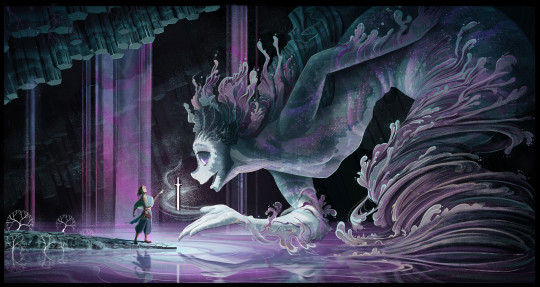
(art by Marie Stephanie Surga on Artstation)
Conclusions
And that’s that! Artifacts are one of those aspects of the game that don’t really come up that much unless the GM allows it or centers a campaign or storyline on the, but the idea of them is integral to themes that often show up in many settings that use the system.
It’s no secret that Lord of the Rings is one of (but hardly the only) influence behind tabletop gaming, so it should come as no surprise that the theme of “Things used to be more magical, wonderous, and arguably better” shows up in a lot of setting, and artifacts can be used to illustrate that perfectly. They’re especially powerful magical items that can no longer be replicated and exist as a reminder of what once ways. (The fact that the titular artifact of LotR was also an evil, refused to use most of its powers for all but the most powerful potential wielders and needed to be destroyed is also pretty influential too.)
But artifacts don’t have to be all doom and gloom relics of a forgotten time that never can come again… or at least if they do, they can also be symbols of hope. Consider that someone made that artifact, maybe not specifically for your character to use, but to be used, even into the future beyond the lifetimes of all that they know. They will never meet your character, but that won’t stop them from, in this tiny way, helping them. Any object made with care, from powerful magical artifacts to a handmade dust towel with extra fabric sewn into the middle to protect the user’s hands from chemicals, is a love letter to all who use it as long as it lasts.
Also consider that artifacts represent the highs of high magic, the upper limits of the sort of miracles that can be stored in a physical object, be they the gifts of gods benevolent or otherwise, the pinnacle of wizardly study, or simply the byproduct of the wondrous metaphysics that govern the setting. In a setting of lower magic, such artifacts might not exist, or they might be terrifying exceptions to the assumptions of the setting which risk upsetting the balance whenever one surfaces.
Artifacts also smack of destiny. Having an artifact you can use, or being tasked with destroying one, gives the feeling of being outfitted by the gods, or shouldered by a great burden respectively. Exactly what they destiny is yet to be seen, but it is an exciting and terrifying prospect regardless.
Truly, artifacts can, had, and do have a major effect on the games they appear in, and while not always appropriate, they always make a splash. It’s up to the GM and players to make that splash a compelling story.
11 notes
·
View notes
Text
Sarcophagus of the Eternal Disaster - Minor Artifact (Shoulders)
A magic item for the Eternally Cursed Child of Disaster, a creature I intend to post later this week.
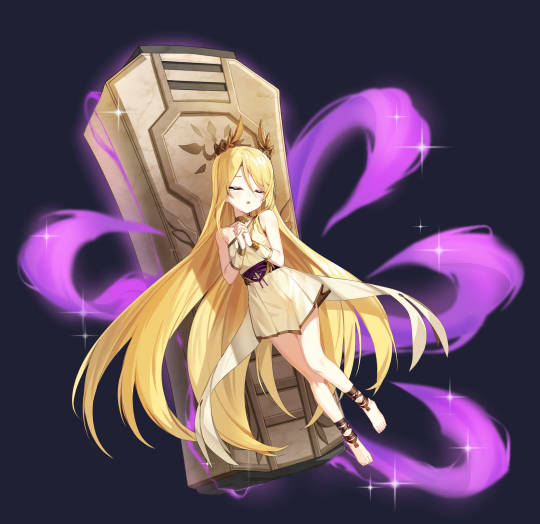
Artwork is official art from Closers, copyright Naddic Games.
Did you ever want to carry around a massive stone coffin on your back as a magic item? ...No? What are you even doing with your characters, then?
So yeah, this is an absurdly powerful legendary artifact. I designed an NPC to use it, but your edgiest player would love to take it and start wearing it around, if you're willing to give them a year of downtime. Because of the year of downtime needed for attunement, an enemy using this item can be pretty safely included in a lot of campaigns without the players actually ever becoming able to use the item and become super powerful. Not to mention that if the PCs take more than one day to start attuning to the artifact after killing its previous owner, it'll revive the NPC and kick them out before they're done.
Sarcophagus of the Eternal Disaster - Minor Artifact
Aura strong necromancy; CL 20th; Slot shoulders; Weight 2300 lbs.
This stone sarcophagus opens on both the front and back (or the top and bottom, if the sarcophagus is lying down). A creature can attune to this sarcophagus by remaining alive inside of it for 1 year without the sarcophagus being opened, after which that creature becomes its owner and can use its magic properties. A creature inside the sarcophagus does not need to eat, drink, or breathe. Once a creature is the sarcophagus's owner, the sarcophagus hovers magically behind the owner's back; it is treated as a cursed item that is worn in the shoulder slot, and cannot be removed from the owner's back except to the owner to sleep inside of it (the side facing the owner opens up to allow her to enter). Removing this curse ends the owner's ownership. Only one creature can be the sarcophagus's owner at a time; if another creature stays inside of it for a year, the previous owner is uncursed and loses ownership.
If the sarcophagus has an owner, a creature other than the owner that attempts to open has difficulty doing so; it is treated as though locked by an arcane lock, and if forced open, it affects the creature that opens it with curse of the ages (DC 22 Will save negates). The owner can open it without issues.
The owner of the sarcophagus of the eternal disaster ceases aging, no longer needs to eat, drink, breathe, or sleep, gains a +4 resistance bonus on all saving throws, gains a 30 ft. fly speed (poor maneuverability) as long as she is wearing it, and can carry, wear, and manipulate the sarcophagus as though it were weightless. Its contents are also treated as weightless for the owner. Any other creature attempting to lift the sarcophagus must contend with the full weight of it and its contents. The sarcophagus holds an 8x2.5x2.5 ft. area of 50 cubic feet, big enough for a medium humanoid to fit inside.
If the owner of the sarcophagus dies, she revives in the coffin 1 year and 1 day later as though by true resurrection, unless another creature has become its owner. If the owner's body is not already in the coffin at the end of this year, her old body crumbles to dust as she revives in the coffin with a newly created (identical) body. If there is not room for the owner inside the coffin, the lid opens and its contents spill out, including the newly revived owner.
At will, as a standard action, while wearing the sarcophagus of the eternal disaster, the owner can imbue the coffin with negative energy, performing one of the following abilities:
Whirling Disaster: The owner grabs the sarcophagus off of her back, transforms the sarcophagus and its contents briefly into pure dark energy, and swings it in a circle, making melee attacks with a +2 enhancement bonus on the attack rolls against up to 5 different targets within 10 ft. Each successful attack deals 2d10 force damage, plus an additional 2d10 negative energy damage if the target is not undead. The owner must have both hands free in order to use this ability.
Death Leaping: The owner transforms into pure negative energy and whips forward in a 40 ft. line, re-materializing at the far end of the line. Non-undead creatures and objects in the path of the line must succeed on a DC 22 Reflex save or take 6d10 points of negative energy damage and objects take damage as per the lightning bolt spell. If the owner runs into an object or barrier and fails to burst through it, the owner appears next to the impacted object and is staggered for 1 round. Movement while in negative energy form does not provoke attacks of opportunity.
Disaster Spread: The sarcophagus opens and releases a blast of negative energy in a 30 ft. cone, dealing 6d10 points of negative energy damage to all non-undead targets in the cone. A DC 22 Reflex save halves the damage.
Entomb: The sarcophagus opens and attempts to suck an adjacent creature inside. The sarcophagus makes a special Drag combat maneuver check at a +20 bonus, which does not provoke attacks of opportunity against the owner. If the check is successful, the sarcophagus closes around the target, trapping it inside. The target is treated as if grappled and swallowed whole by the sarcophagus, as the swallow whole universal monster ability, taking 1d10 negative energy damage immediately and another 1d10 damage each round it remains inside the sarcophagus. A trapped creature can break free by dealing 30 points of damage to the inside of the sarcophagus, which has 10 AC and 8 hardness, or by making a DC 22 Strength check. Damage dealt to the coffin is automatically magically repaired after 10 minutes.
Curse of the Entombed: The owner attempts to curse a creature that is currently inside the sarcophagus. The target must succeed on a DC 22 Will save or be cursed as if by the bestow curse spell.
End of the Entombed: The owner attempts to deal 10d10 negative energy damage to a creature that is currently inside the sarcophagus and already cursed by bestow curse. A DC 22 Fortitude save halves the damage. This is a death effect. If the target dies from this effect, the owner immediately becomes aware of it.
Return of the Entombed: The owner attempts to turn a dead creature inside the sarcophagus that was killed by End of the Entombed into a mummy, as if casting create undead on it. The mummification process takes 1 week, during which the coffin is sealed shut and the coffin's abilities cannot be activated (but it retains its passive properties such as weightlessness and flight). The owner can cancel this ability at any time, but if she does so, the corpse crumbles to dust.
None of the negative energy damage dealt by a sarcophagus of the eternal disaster heals undead creatures. Undead are unaffected by the negative energy damage, though they may still suffer other effects of these abilities.
DESTRUCTION
The sarcophagus of the eternal disaster crumbles to dust if its owner and creator are both dead, 1000 points of positive energy healing/damage are applied to it within the span of 10 rounds, and remove curse is successfully cast on it within that same span of 10 rounds.
5 notes
·
View notes
Text
“Your Grace. Are you here for a story?”
“Storyteller… yes. A happy one, please. No – wait. A tragic one. If you may.”
The wizened elf hesitated, blind eyes staring past Calissa. “Something troubles you, your Grace. I can hear it in your voice. If you would like, I can listen instead, and you can tell your story. Perhaps it will ease your burdens.”
Calissa shook her head mutely – then sighed, realizing. “No, thank you. This story… I can’t tell this story yet. It isn’t over.” Her hands found each other, wringing, writhing. “It can’t be,” she added quietly.
The Storyteller made a knowing noise in his throat. “There are many stories of darkness. Evil, and tragedy, and hatred… but many end in the triumph of good. Oftentimes, from darkness comes light.”
The word seared. Light. The sun in her blood, the taunts, the whip licking across her back. Tristian’s hands, full of the light of Sarenrae, palms pressed to his eyes.
Light.
What had light ever done but burn her?
“I’m sorry, Storyteller. I – I need to go.”
Hurried, shaky steps carried her away, ringing hollow against the stones.
#also dealing with feelings about this quest (vordakai's tomb) by writing drabbles#in the game the first thing i did after getting back to tuskdale is go to the storyteller with a completed artifact#and he told me a HORRIFIC story#so that's canon now#the light of the sun#inquisitor calissa#pfkm#pathfinder kingmaker#tristian#ana writes things
1 note
·
View note
Text
The High Noon
The High Noon
Magic Item/Cursed(???) Weapon/Artifact
The High Noon is a +4 Dueling Pistol made out of Warpglass,with many symbols emblazoned upon the grip. Strangely enough, The High Noon cannot deal lethal damage to its targets, instead focusing on transferring the effects of the Warpwave with great efficiency. On a successful attack, roll for an effect on the Warpglass Chart.
WEAPON STATS
CATEGORY: Marital Weapon, Ultra Rare
GROUP: Firearm
BASE: Dueling Pistol
WEAPON RANGE: 60 Ft
Reload Time: 1
PRECIOUS MATERIAL: Warpglass
POTENCY RUNE: +4
BASE DAMAGE: 1d6 Untyped (Nonlethal)
TRAITS: Concealable, Concussive, Evocation, Fatal d10, Magical, Nonlethal
#pathfinder 2e#pathfinder homebrew 2e#pathfinder weapon#pathfinder#homebrew#fantasy#ttrpg#magic item#artifact#pathfinder 2e homebrew#pf2e homebrew#pf2e
1 note
·
View note
Text
VIVERE

“Do you think you deserve it? To be punished?”
“I think so, yes.”
A Pathfinder 2e Campaign Introduction Post!

MEET THE PARTY:
REVUN (@dovelydraws)
26 years old
he/they/she
A duel-wielding tiefling fighter. Easy-going freelance mercenary from Alephia, looking for a job that pays well and a little company.
FERRA (@artpepkin)
87 years old
she/her
A beastkin elven rogue from Chiei Thya. Playful vagabond who finds herself wherever the wind takes her. She's maybe gotten herself in a little over her head.
POLITES (@mossy-garden)
17 years old
he/him
A tiefling champion. Proud kingdom guard of Crimyria under the goddess Vildeas, who is willing and anxious to prove himself.
KWAN (@jinbugs)
39 years old
he/they/she
A human investigator. Cunning Po Lian scholar-official informant who is in pursuit of a dangerous secret, the centurion pearl. At any cost.
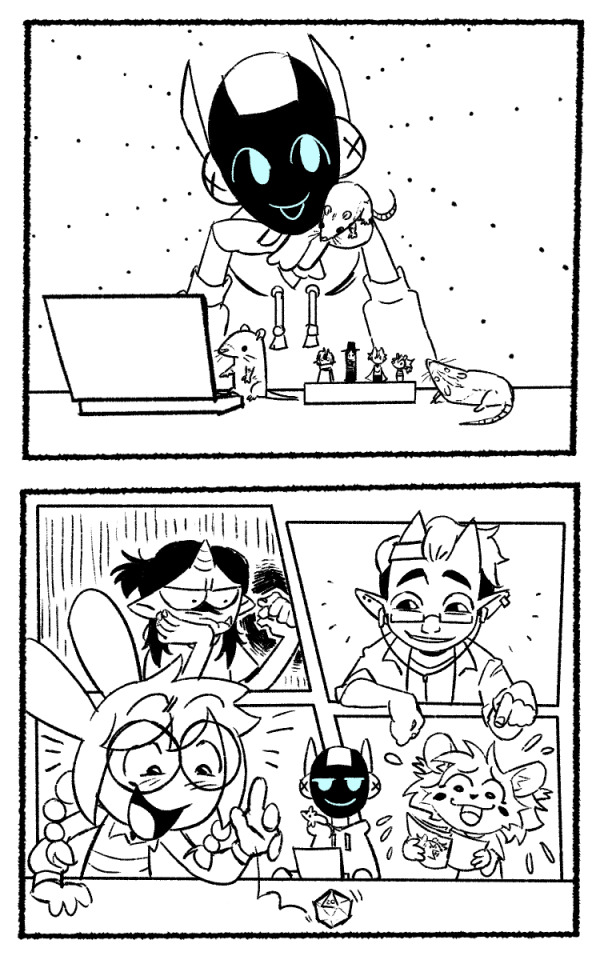
Glitch (@eternalglitch), our game master, weaves all our loose threads into one coherent story.
One fun rule we’ve incorporated into this campaign: players CANNOT share their character backstories with each other outside of gameplay.
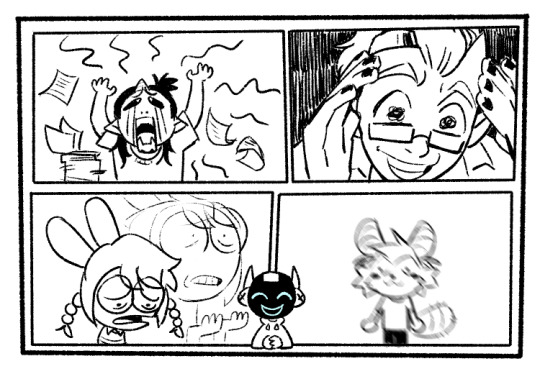
It gives more mystery fun! It’s also driving us insane. Pray for us.
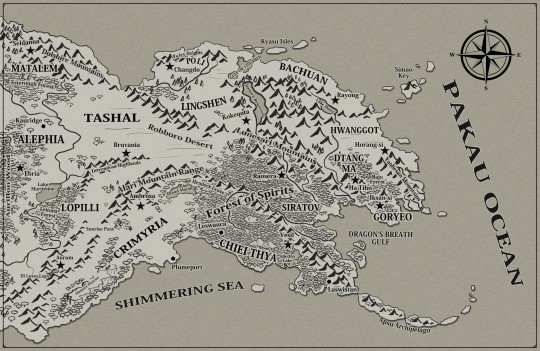
(Map created by @dovelydraws, summary also written by Dove)
A lot has gone into the cultures and politics of each of the countries our characters come from. Enough so that it doesn't make sense to get into all of it on an introductory post! But perhaps later in a reblog.
THE STORY SO FAR…
As of the writing of this post, we have now played 5 sessions of the campaign.
Our party all met each other in the small seaside town of Plumeport, Crimyria. We were all brought together in pursuit of the same thing: a legendary man-eating boar, said to hold the power of immortality.
It is believed that consuming the flesh of this boar would grant eternal life, and even just a bit of its fur or blood can extend a person's life, for a time. The King of Crimyria himself has offered whoever can take down this boar a large sum of wealth and a small offering of its blood for personal consumption. He wants the job to be done in time for the Crimyrian Festival of Flight, in a couple months time.
The bounty on the boar's head has drawn adventurers from all over the continent, but none so far have been able to take it down. Many have lost their lives. While each of our party members have their own reasons for wanting to take on this job, Kwan has a very personal stake in their success.
He has, reluctantly, revealed that he once knew the boar before it obtained the power it has today. He has reason to believe it has swallowed something once known as a centurion pearl: a powerful artifact that caused the fall of a once great kingdom, and threw the continent into tumultuous conflict. Kwan is adamant that this power should not be handed over to any king. Once it is killed, they want to extract the pearl from its body to make sure it can never fall into the wrong hands.
So far, Kwan has only revealed this to Revun. Polites, meanwhile, works directly under the king and wants to succeed on this mission to make him proud. Ferra seems to only be interested in the money and adventure. Revun has also said they were in this for the money, but vaguely admitted to Kwan that they also had their own personal reasons to go after the boar, and if he truly believes its power is too dangerous, they will follow his lead.
Once faced with the boar, however, the party was unprepared and outmatched. It was massive, its eyes as large as their heads, emanating a golden glow. It moved unlike a normal animal, and seemingly bore a higher level of intelligence than it should.
After a deceptively strong start, Polites went down in battle, and they were all forced to run to ensure everyone's survival. Before retreating though, Kwan shot the boar with a strange arrow, claiming they would be able to track it again later.
The party camped outside of the marsh, unable to sleep while waiting for Polites to wake up. They discussed next steps- going back to the city to regroup, get proper healing, and perhaps find a sponsor to help them in their next try. They still have a few weeks to get things figured out.
And that's all, so far! We're all pretty stoked and making tons of art and written works, so keep a look out, we might publish a zine when the sessions start wrapping up. Bye-bye, for now!
250 notes
·
View notes
Text
Sooooo the pathfinder kobold lore got way more interesting. Part of the reasons kobolds tend to follow larger more powerful creatures(often dragons but not exclusively) because there eggs absorb the latent magical energy that comes off these creatures. These creatures also dont even have to be creatures at all but sometimes powerful magical artifacts.
They even have art of a Kobold that has like crystal horns and moss growing on them. It's the art for the "kobold cavern mage"
40 notes
·
View notes
Text
On Mystra and Gale
Okay I gotta say it.
tl;dr: Gale is too old to have been groomed by Mystra (unless you headcanon him as 30 or younger), bc she was dead until 1479 (game year is 1492). I am not defending Mystra. Mystra is a mess. Her (FR) writing is a mess. But for this at least, the timeline doesn't add up.
Disclaimer: there is absolutely nothing wrong with people disregarding/tweaking lore for fan works/fanfic. God knows I do it all the time when I GM. That's your story now and you can do whatever you want with it, including exploring problematic relationships like what if Gale was groomed by Mystra? This is just a post for general information. Write what you want. Explore those dark recesses of the human heart. Fly free, you beautiful butterfly.
Too long but still gonna read explanation under the cut.
Let me preface this again: This is not a post in defense of Mystra. I have, in fact, been very loudly complaining about Mystra since long before Baldur's Gate 3 was even hinted. This is simply pointing out timeline discrepancies that it seems many newcomers to Forgotten Realms aren't aware of (totally understandable! You should not need to ingest 30 years of lore to enjoy a game and I'm not saying you do.) Additionally, FR literally kills Mystra every new edition and it gets dumber every time.
Anyways. It is highly unlikely that Gale was groomed by Mystra. This is not a statement of morality, it's a statement of timeline.
Mystra died in 1385. She was in pieces (like bits of her magic were still in artifacts/her Chosen, such as Elminster in lore that I absolutely despise) and that, as far as I can tell, is how magic subsisted until 1479, when she was reconstituted by Elminster (in lore that I absolutely despise) This is a gross oversimplification of an event called the Spellplague. I am open to correction on how magic worked here because I moved to Pathfinder during the 4e era and you could not make me read those Elminster books if you put a gun to my head.
Regardless, from 1385-1479, Mystra was dead/missing/asleep.
BG3 takes place in 1492. If Gale is 40 years old, he was born in 1452. This means, if Gale is 40, the youngest he could have been was 27 when Mystra contacted him. This lowers, obviously, if you think Gale is 35 or even 30. If he's 30 then Mystra could have contacted him at 17. Yes, a 17 year-old is a child and this could have led to grooming, but Mystra wasn't at full strength when she first returned and she most likely wasn't seeking new Chosen until the next year, 1480. Regardless, this is the reason I put grooming as Highly Unlikely instead of Impossible. I personally believe Gale is older than 30 (I say this as a person in their 30s), I believe he was written with the intention of being a man older than 30, and I cannot see him being in his 20s. (more power to you if that's your headcanon, he's an archmage, he could be 600 for all we know, fly free, etc)
OKAY THAT SAID. Would she have groomed him? Fucking probably! Mystra is a mess. I have been playing in Forgotten Realms in tabletop and video game settings for going on 25 years now and let me tell you. Mystra is a mess. I could make a whole long ass other post on all the many problems I've had with her writing over the years. Even without the "Mystra banged a minor" angle here, there is a serious power imbalance and very obvious manipulation on her part. And I'm here to tell you Gale isn't even the first wizard she has done this to! She's done much worse! Mystra has a ton of flaws (I could write a BOOK on Mystra's flaws) but it remains highly unlikely that grooming Gale in particular is one of them.
If you'd like more FR lore this person has some amazing lore write-ups that I really enjoyed reading during EA. And here is Mystra's forgotten realms wiki page, already linked to her death and return.
(my friend told me to post this after I kept bitching to them about Lore on discord and They Know Who They Are)
#Baldur's Gate 3#bg3#gale of waterdeep#Gale Dekarios#Civilized lore discussion/questions welcome#If you hate on Gale on this post I will block you#mystra lover/hater since 1999#it's complicated ok#mystryl didn't die for this#forgotten realms lore
106 notes
·
View notes
Text
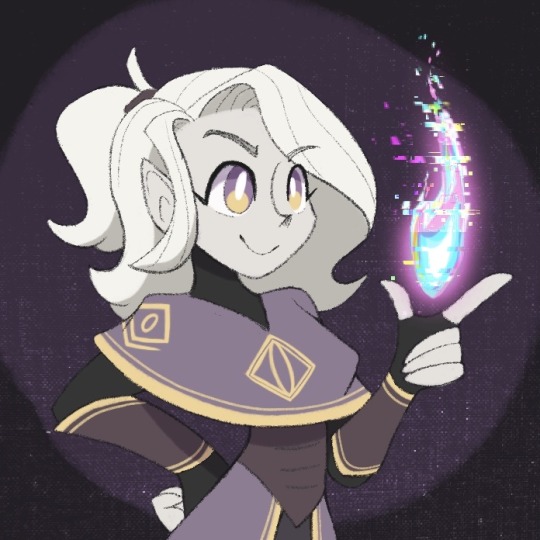


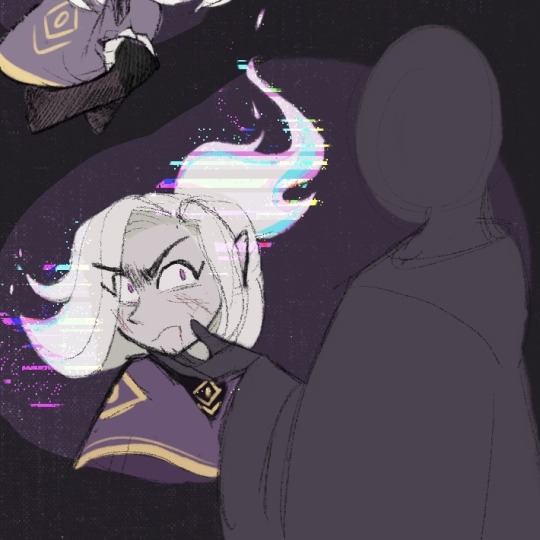

i am going to finally start posting what I’ve been working on!!!
my girlfriend and I have been world-building together for a homebrew pathfinder campaign that she started running for us and some friends- this is a character i’ve had for 3 years now, but only really started developing her story and whirling her around in my brain at mach speeds in the last couple months or so
i’ll put some lore and a couple other sketches under the cut. i’m also going to try and set up a queue for the other art and sketches i’ve made for the campaign so far, so watch out for that!
--------------------------------------------------------
Have you heard of a whale fall?

Imagine being a creature living on the bottom of the ocean floor- life is hard. It's cold, it's dark, food is scarce.
Suddenly, a giant, incomprehensible being floats down from the heavens. You and hundreds, maybe thousands of organisms clamor to the remains of the beast, a sudden beacon of prosperity in this wasteland, desperate to get even a scrap of its of life-giving nutrients. Every creature that partakes will have a piece of that being inside of them forever- fueling them, giving them life, becoming a part of them.
Do you think these creatures would worship such a being?
Would they consider it a god? Salvation?
In the world of Omna, remnants of old gods past have fallen down from the divine realm and settled in the mortal plane. Their remains are what have created the landscapes of this world (mountain ranges, valleys, islands, etc). Mortals who live and dwell upon the remains find themselves changed slowly throughout the generations- changed by the faint fragments of the gods lingering power.
--------------------------------------------------------
ok. now for my character
Name: Felise Pfeiffer (Fell)
Age: 19
Class: Cosmos Oracle
Background: Scholar (Arcane)
Felise is a cosmos oracle- which means her powers come at the cost of a curse that slowly takes over her body. Instead of something like stars, I wanted her curse to appear as this sort of.... corrupted, glitchy, chaos-y aura. It's very closely tied to her emotions, so when she gets really worked up, the static progressively expands around her.
After she was "cursed", if she let her emotions get away from her, she risked hurting herself or other students at her academy. In order to avoid becoming a threat to the other students and faculty, and ultimately getting kicked out of school, she devised a number of strategies to help keep her emotions in check. (mechanically this is her settle emotions/refocus action. I'd like to think she uses the time to focus on slowing down her breathing. She uses her dancing lights cantrip to help- i imagine her spinning the lights around in her hands meditatively, kind of like baoding balls if you know what those are)
(also yes, her curse magic manifesting is the equivalent of a panic attack)
She's covered up a lot of her body to try and hide as much of it as possible, but her hair is always a dead giveaway. She leaves her fingers exposed since it's easier to channel magic through exposed skin (gloves, unless made of a special magic-conducting material, tend to dampen spells just a bit) - but this means others can see her fingers start to shift into static as she uses her cursed magic.
I had a lot of really intense anxiety in junior high/high school/college, so she's become a really neat vessel for me to conceptualize and process those experiences and emotions. But, like, instead of having undiagnozed ADHD and RSD she gets like. cool magical girl powers
BIO:
Felise was the sole child of local inventor and archeologist, Atticus Pfeiffer. Her father's lifelong devotion was to study and uncover the mysteries of the ancient winged people known as the Featherfolk, who had seemingly vanished some 1000 years before. She grew up in a cottage built on the coast of a mysterious bird-shaped lake, where she and her father would excavate broken murals, walls of hieroglyphs, and other artifacts that hinted at the lives of this forgotten feathered-society.
Until just under 10 years ago- when her father mysteriously vanished.
From then on, reports of strange attacks began sprouting up all over Aton and other neighboring regions. Attacks fronted by giant, chimera-like bird monsters that would descend from the sky to snatch up unsuspecting victims- carrying them away to some unknown in the sky.
Felise did her best to pick up the pieces of her father's research- hoping to find the cause behind the sudden appearance of these monstrous aberrations, the reason for their attacks, and maybe, just maybe, where her father disappeared to all those years ago.
--------------------------------------------------------
you did it!! i give you tasty treat for reading my lore dump! even if you didnt thats ok, you must have at least clicked the read more and scrolled down. you can still have a little treat
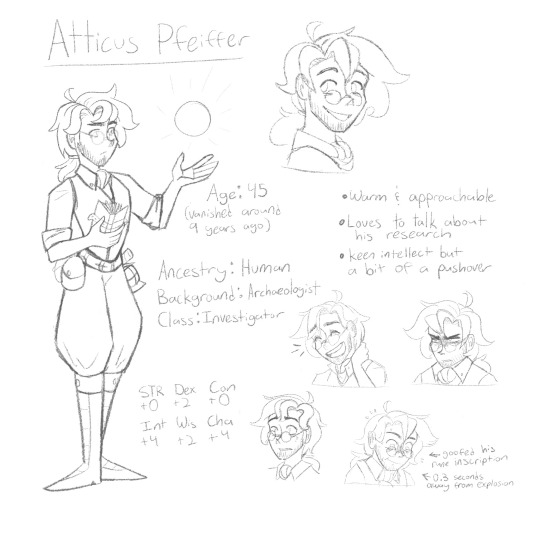
an unfinished reference sheet for her dad, atticus

these are my girlfriend @im-ashl sketches - Skraaw, The Carrion King - the BBEG of the campaign, an Evil Bird who is Awful
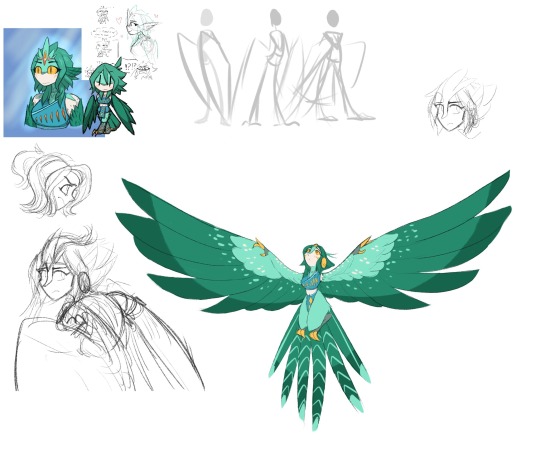
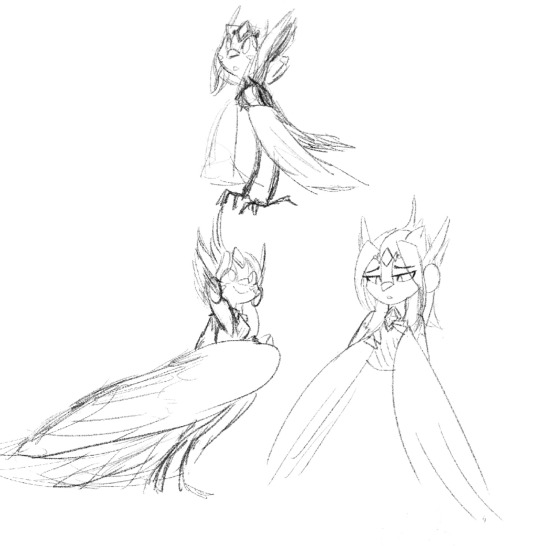
and finally some sketches of- whos this? the featherfolk princess??
#im still. figuring out how to draw people#so my style isn't really consistent yet if u cant already tell#but it's been a lot of fun and i've been drawing more than ever#so i hope you like it!!#pathfinder#pathfinder 2e#ttrpg art#cosmos oracle#felise pfeiffer#me art
25 notes
·
View notes
Text
Astonishing Artifacts: The Codex of Infinite Planes.
Source: Pathfinder Campaign Setting: Artifacts & Legends.
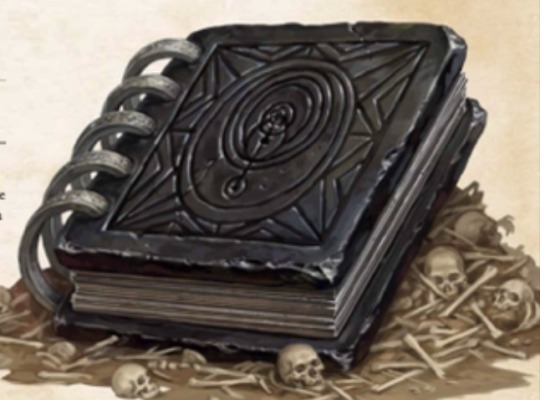
Image source: Pathfinder Campaign Setting- Artifacts & Legends, Pg. 19.
“Thick slabs of obsidian bind pages of fine lead, creating a massive tome riddled with pocks and scars suggestive of fantastic antiquity.”
The Codex of Infinite Planes is an enormous tome, usually requiring two people to properly handle, and has a seemingly infinite length of pages. It offers incredibly vast knowledge of the multiverse, at the risk of being totally annihilated by the power of the book.
Risk and Reward. When a being first reads the Codex, their will is tested by the multiverse. Should they be deemed unworthy, they are destroyed and wiped from reality. If they succeed, all the knowledge held within can be accessed, granting information and powers relating to planar travel.
Planar Catastrophes. When the powers of the Codex are used, there is always a slight risk of triggering some calamity. These dangers are seemingly random, yet always have disastrous effects on the user and surrounding area.
Destruction. The Codex can only be permanently destroyed if every single page is ripped out and left on a separate plane. Given the powers held within the Codex, this sounds relatively simple, but just the act of tearing a page out of this book will always immediately trigger a catastrophe.
History of the Codex of Infinite Planes:
Few in the multiverse recollect when the Codex was created, and for many its origins are lost to antiquity.
In a time before the first mortal races walked the planes, the Titans were rebelling against the gods to try and take their divine power.
They realized they couldn’t defeat their enemies without some connection to the multiverse, and sought to twist the planes to their will.
The result of this ultimately failed but fantastic bid was the Codex of Infinite planes, a tome allowing a being to access the multiverse.
The punishment for the creation of this book was swift, and the titans and gods fought in an eon-spanning war.
The Codex eventually was lost, and has gone through periods of inactivity over time. It shows up throughout history, offering miraculous power and information but inevitably devastating the societies that unearth it.
Catastrophes & Ramifications:
Each time the powers of the Codex are used, there is a chance it will trigger some event determined randomly by the book.
Some of these possible events are:
The reader and everything in a 5-mile radius is transported to a different plane.
A vicious storm centers on the area, followed by periodic earthquakes.
A small group of fiends are summoned with one goal: To kill the reader.
The reader’s soul is permanently captured in a mundane gem.
Every dawn after triggering the catastrophe, the reader reincarnates into a new form.
Evil clones of the reader from other dimensions begin appearing in the area, each bent on killing the reader.
Hundreds of spirits pour out of the book, each determined to kill a specific mortal.
The reader’s soul is permanently bound to their body and barred from the afterlife; If they die, their spirit stays in their inanimate body.
The reader becomes colossal in size, and continues to grow every day.
The reader’s energy is drained by the book, constantly hobbling and weakening them daily.
Any time the reader interacts with magic, it risks being unraveled.
The reader becomes known by a specific deity, who vows to destroy them by any means.
All magic in the area permanently stops functioning.
Magic becomes twisted and warped, creating a pocket of wild magic in the area.
The land within a few miles of the reader is permanently cast into darkness.
The temperature of the area raises 40 degrees as the sun halts in the sky.
All creatures in the area risk dying and immediately coming back as highly infectious zombies.
2 titans appear and immediately begin to fight over the Codex.
A meteor shower pummels the area.
Gravity in the area is distorted or reversed.
Every being within 20 miles except for the reader permanently switches alignment.
The reader permanently swaps bodies with their greatest enemy.
The reader drops dead, killed by a spell. If they are too strong, the Codex repeats this effect until they die.
Constant Search. Beings across the multiverse are constantly seeking the Codex out. Many different factions are interested in its use, as access to the multiverse is something nearly any being wants. Some beings wish to use it selfishly, bending the planes to their will, while others wish to hide it from those that would use it for evil. Regardless of the intentions of the reader, the Codex causes tragedy wherever it resurfaces.
Ideas for using the Codex in your campaign:
The party is working on an unrelated objective when they are caught in the effect of one of the Codex’s Catastrophes. They must find the Codex and stop its reader before they trigger another.
The party requires access to a closed plane— possibly the dimension of time, a hidden layer of the Abyss, or some other obscure and hard-to-reach place. The quickest way to get to this place would be to risk using the Codex, if they can find it.
A group of titans have appeared in the realm, threatening to destroy the area with their schemes. The party must seek out the Codex to use as a bargaining tactic to make the Titans leave their plane.
Many beings, myself included, would risk much for access to the Codex of Infinite Planes.
Imagine if you had the powers this book offered— Planar travel, powerful spells, and knowledge regarding the multiverse. Who wouldn’t risk it all for that?
That is a part of the inherent danger of the Codex. So many factions across reality are ever searching to use it, with very few realizing the calamity that would follow.
Not many beings in the multiverse are strong or responsible enough to wield the power of the cosmos.
- A Weird Warlock.
#wowieweirdwarlock#pathfinder#ttrpg#pathfinder lore#codex of infinite planes#planes#WWW: Astonishing Artifacts
4 notes
·
View notes
Text
Breaking and Exiting | Magical untensils to break into and out of any situation

PDFs of this and more can be found over on at my Patreon here!
I release everything for free, so your support makes this possible.
I'm working on a new class for 5e! Follow the Kickstarter here!
Welcome to the new month, a combo theme of fortress and escape. While the intent for these items were to escape, they, admittedly, also work to infiltrate a fortress. Ha! Perfect segue between topics :)
Adamantine Battering Ram
So, the trait of adamantine weapons, besides bypassing damage immunities is that it autocrits structures and objects, like doors. Well, it makes sense then that you'd want an adamantine version of an object all about breaking down doors.
Counterfeit Skeleton Key
Doing things in alphabetical order is amusing sometimes. This is, as the name implies, a replica of the artifact in this list. Because of course you want a magic key that automatically unlocks any door. Did steal the idea of several conceptual versions of this item from media consumed long ago that I no longer know where it's from where it moulds itself to the lock it fits into and stays like that. Or I hallucinated that memory, I honestly couldn't tell you.
Inconspicuous Crate
A Metal Gear reference, haha! Also coincidentally not the first mind altering box I've made, huh.
Instant Hole
So, the robe of useful items potentially includes a window or a pit that you can just slap onto the ground or a wall, but that's the only way to get such a marvelous item. I thought it might do to make an actual item out of it. Yes, this is based on the portable hole from Who Framed Rodger Rabbit. I just couldn't name it such, because apparently that item already exists but isn't really a hole. Now is it?
Mithral Lockpick
I miss masterwork thieves tools. I also find the general lack of improvements for the most used tool a little odd, actually. It's not much, but it's nice.
Skeleton Key
Behold! The most common fantasy magic item in existence. Including the item of the same name from the elder scrolls that I borrowed some of its abilities of (AKA the unlocking of potential), and pathfinder's "Perfection's Key" which I borrowed the destruction method of. Strangely, the closest item 5e has is the chime of opening, which is a temporary item and loud. Neither of which I would recommend for sneaking.
And now to plug my stuff. I release homebrews weekly over on my Patreon.
Anyone who pledges $1 or more per post don't have to wait a month to see them, and also help fund my being alive habit.
At the moment, they have exclusive access to the following:
Dungeon Delver's Survival Guide
Oath of Integrity
Path of Iron
Stranger than Fiction
I also have three classes, and a splatbook over on DriveThrueRPG to check out:
The Rift Binder. A class specialising in summoning monsters and controlling the battlefield.
The Witch Knight. A class that combines swords and sorcery in the most literal way.
The Werebeast. A class that turns you into a half beast to destroy your foes.
d'Artagnan's Adventurer Almanac. A compendium of races, subclasses, feats, spells, monsters and more!
17 notes
·
View notes
Text
Roleplay Ramblings: Artifacts part 3

(art by RobertCrescenzio on DeviantArt)
Using Artifacts
So yesterday we talked about the kind of stories that you can use artifacts for, but now let’s take a moment to talk about how to implement them correctly.
By their very nature, artifacts are very powerful items, ranging from stronger than an equivalent item of the same caster level to absolutely game-breaking, meaning that introducing one to a campaign can be difficult to pull off well.
Perhaps one of the most notorious examples is the Deck of Many Things, which can have many powerful effects that can disrupt or even entirely derail a story. As such, it probably only really works with campaign styles that are almost entirely freeform and improvised.
Others prove dangerous purely because they give the heroes access to powers that completely subvert or trivialize the threats and challenges you seek to include in your game, so you should probably review the abilities of not just the heroes but any loot, especially artifacts, that you’re considering giving to the party before designing dungeons.
If you plan to dole out multiple artifacts or an artifact that benefits the whole party, be sure to adjust the power of the threats in question. Some might consider this artificial, but remember that by Watsonian thinking, these heroes were destined to fight such mighty foes, and the artifacts were gifts of fate to better face them.
Of course, sometimes the fact remains that an artifact was given in error, that such a powerful tool completely derailed everything. When this becomes apparent, its’ time to talk to the gaming group and decide how to remove it from game. This may include rolling back time to before it was acquired, or it might involve finding ways to remove the artifact from the game within the context of the game. Perhaps it is stolen, or maybe destroyed, or maybe set aside until the heroes can properly handle it’s power if you want to bring it back later.
That does it for today, but tomorrow we’ll talk about why artifacts are normally impossible to make, and what happens when you break that assumption. See you then!
4 notes
·
View notes
Text
So what is Jandelay?
One of the earliest and longer-running mysteries in Pathfinder was the identity of the mysterious Jandelay, mentioned only in the statblock of the Oliphaunt of Jandelay. In Mythic Realms, it remained ambiguous if Jandelay was a creature, an event, a plane, or some other mysterious entity, with the only hints about it being the poem carved into the base of the enormous Spindlethorn:
Jandelay, proof against the Maelstrom,
Jandelay, of green fields and faultless spires;
No sane soul born dares trespass fair Jandelay
For the Oliphaunt guards you always.
But five years later, (almost) every question about the mysterious Jandelay was answered in Planar Adventures! It’s a demiplane, but not just any old demiplane! It is a bubble of pure Law floating on the surface of the Maelstrom in stark defiance of the Maelstrom’s desire to subsume all that is back into chaos. It refuses the Maelstrom’s pull and instead exploits the source of all quintessence, drawing it out as needed in order to maintain itself for its unique purpose.
Also known as the Apocalypse Archives, Jandelay is a realm of rolling green grass fields with alabaster spires placed regularly throughout... and thousands upon thousands of stitched-together, chimeric and chaotic arrangements of various biomes, architectures, and environments. Whenever a Watcher places a Beacon of Jandelay down upon a doomed world, it marks that section of the planet for collection by the plane. When the world is destroyed by the apocalypse which summoned the Watchers in the first place, every area marked by the Beacon is torn from the world and placed on Jandelay, merged together with other marked sections with little regard for whether or not the arrangement makes sense, but the magic of the plane and the attentions of the Watchers maintains these sections even when they would have logically crumbled away or annihilated one another (such as if a section of glaciers ended up next to an active volcano). Sapient lifeforms preserved by the Watchers are combined into a Collected, a form of Outsider with the minds and memories of dozens or perhaps even hundreds of creatures, bound eternally to the stitched remains of the world they were “rescued” from and allowed to wander it, but no further.
It’s not directly stated if animal life is taken along for the ride, but what IS canon is that Watchers use their perfect memories and passion for crafting, as well as knowledge obtained from the Collected, to build facsimiles of various flora and fauna that didn’t manage to get saved, using their constructs to decorate the world-sections. Despite this adorable behavior, Watchers don’t exactly make for good company, so the Collected tend to live a lonely existence. It’s not like anyone really visits.
Any knowledge about Jandelay is understandably difficult to come across. How the Runelords learned anything about the Oliphaunt or the plane itself is a mystery that yet endures, because dimensional travel straight up does not work. Any attempt to use Plane Shift or ANY other form of dimensional travel to enter, exit, or even just travel around inside Jandelay fails if the user doesn’t succeed a DC 41 Will save (something the Watchers must be innately immune to despite their statblock saying no such thing, else they can’t escape or re-enter their own home if they roll lower than 15), and Gate or similar effects fizzle automatically without allowing a save unless the caster is Mythic or the source is an Artifact.
So to even know about it, your world will already have to be on its way out the door. You need to succeed a DC 28 Will save (or be immune to Inconspicuous) to see a Watcher, NOT freak out about it, then convince it to tell you a little about itself, and then further convince it to tell you about Jandelay... and if you want to GO there, that’s a DC 41 Will save or you simply can’t without burning another spell slot or resource to try again. And Armageddon continues to breathe down your neck as you try again! And if, by some miracle, you end up there? Well, good luck getting out with any swiftness, especially since you’d need to not only have more castings of Plane Shift, but a safe destination in mind to recollect yourself as you grapple with knowing your world is gone. That kind of thing changes a person! Is it any wonder why knowledge about Jandelay is so hard to come by, when the conditions for gaining even tiny scraps are so severe? (No, you can’t just summon a Watcher; they have far too many HD for anything lower than Gate to work)
It’s not super dangerous in the archives, at least. if you wanted, you could wait to get your slots and sanity back while looking at the past destroyed worlds. Maybe even find your own. The Watchers don’t attack creatures who merely examine the exhibits--that’s what they’re there for, after all--but any attempt to damage them and you’ll find out there’s a lot more of the creepy crawlies than you know about hiding just outside your senses.
And then there’s the Oliphaunt itself. Chaos made manifest, a mountain made flesh, a storm given purpose. It’s the Oliphaunt that protects Jandelay from all intruders, its own presence the one that imposes the travel restrictions for reasons that can only be guessed at (which means that if it’s NOT in Jandelay, one can travel there without making a save! easy, right?) and the greatest deterrent to the Proteans who’d otherwise object to Jandelay’s presence. The origins of the Oliphaunt, and of Jandelay, are stated in surprisingly plain terms: the Oliphaunt created itself, and made Jandelay soon after. Then, Jandelay itself birthed the Watchers to tend to it. The Oliphaunt is stated to be the incarnated form of the idea of the apocalypse; the manifestation of calamity and destruction on a planetary scale, drawn to observe its collection of destroyed worlds for its own inscrutable reasons.
It leads me to believe it was born shortly after the rampage of Rovagug, the collective dying gasps of thousands of worlds and gods coalescing into a single being, and it created Jandelay as a method to assure no more worlds would be forever lost and forgotten; something by no means canon, but it makes the most sense to me. What also is not canon but makes sense to me is that the Oliphaunt, as the incarnation of world-destroying calamities, should not be an entity the players can reasonably fight. We’ll see how I approach this particular challenge this Friday!
108 notes
·
View notes
Text
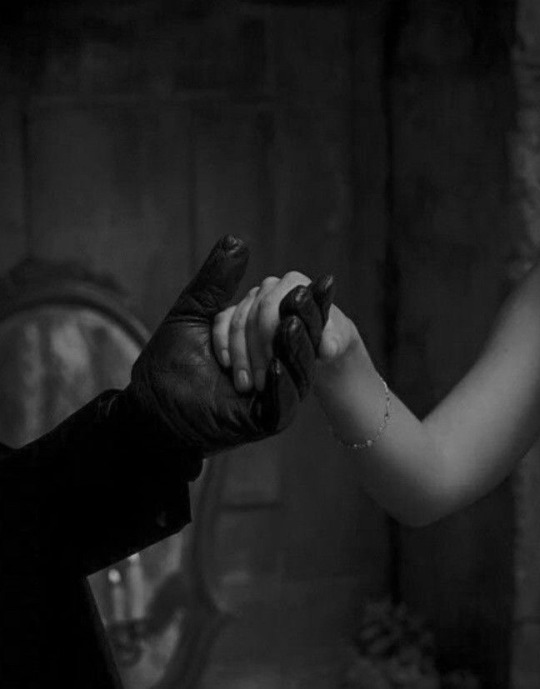

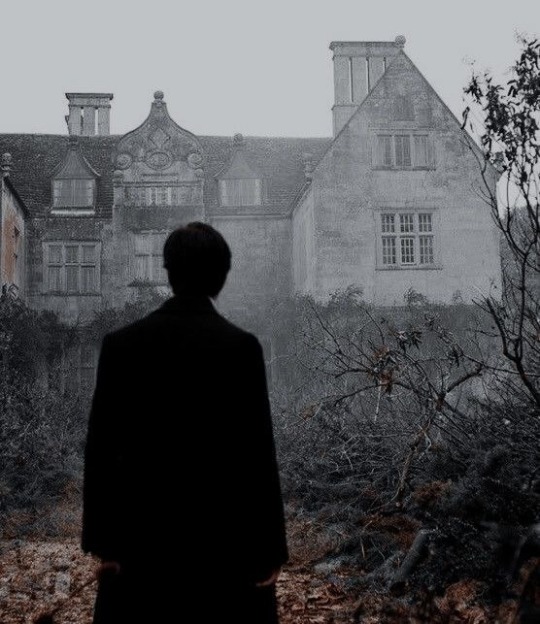

𝘗𝘦𝘳𝘩𝘢𝘱𝘴 𝘺𝘰𝘶 𝘸𝘦𝘳𝘦 𝘥𝘦𝘴𝘱𝘦𝘳𝘢𝘵𝘦, 𝘰𝘳 𝘢𝘭𝘰𝘯𝘦, 𝘸𝘰𝘳𝘴𝘦 𝘺𝘦𝘵 𝘱𝘦𝘳𝘩𝘢𝘱𝘴 𝘺𝘰𝘶 𝘸𝘦𝘳𝘦 𝘷𝘶𝘭𝘯𝘦𝘳𝘢𝘣𝘭𝘦 𝘣𝘺 𝘯𝘰 𝘧𝘢𝘶𝘭𝘵 𝘰𝘧 𝘺𝘰𝘶𝘳 𝘰𝘸𝘯. 𝘌𝘪𝘵𝘩𝘦𝘳 𝘸𝘢𝘺, 𝘩𝘦 𝘧𝘰𝘶𝘯𝘥 𝘺𝘰𝘶 𝘢𝘵 𝘺𝘰𝘶𝘳 𝘭𝘰𝘸𝘦𝘴𝘵 𝘮𝘰𝘮𝘦𝘯𝘵, 𝘩𝘦 𝘰𝘧𝘧𝘦𝘳𝘦𝘥 𝘺𝘰𝘶 𝘦𝘷𝘦𝘳𝘺𝘵𝘩𝘪𝘯𝘨.
𝘐𝘵 𝘸𝘢𝘴 𝘮𝘰𝘳𝘦 𝘵𝘩𝘢𝘯 𝘺𝘰𝘶 𝘯𝘦𝘦𝘥𝘦𝘥 𝘵𝘰 𝘴𝘶𝘳𝘷𝘪𝘷𝘦, 𝘪𝘵 𝘸𝘢𝘴 𝘦𝘷𝘦𝘳𝘺𝘵𝘩𝘪𝘯𝘨 𝘺𝘰𝘶 𝘩𝘢𝘥 𝘦𝘷𝘦𝘳 𝘸𝘢𝘯𝘵𝘦𝘥 𝘰𝘳 𝘮𝘰𝘳𝘦. 𝘈𝘯𝘥 𝘸𝘦𝘭𝘭, 𝘪𝘧 𝘺𝘰𝘶 𝘥𝘪𝘥𝘯’𝘵 𝘩𝘦𝘢𝘳 𝘵𝘩𝘢𝘵 𝘰𝘧𝘧𝘦𝘳 𝘵𝘩𝘦𝘯 𝘸𝘩𝘰𝘦𝘷𝘦𝘳 𝘱𝘶𝘵 𝘺𝘰𝘶 𝘪𝘯 𝘵𝘩𝘦 𝘱𝘰𝘴𝘪𝘵𝘪𝘰𝘯 𝘺𝘰𝘶 𝘧𝘪𝘯𝘥 𝘺𝘰𝘶𝘳𝘴𝘦𝘭𝘧 𝘪𝘯 𝘯𝘰𝘸 𝘤𝘦𝘳𝘵𝘢𝘪𝘯𝘭𝘺 𝘥𝘪𝘥.
𝘛𝘩𝘦 𝘒𝘪𝘯𝘨 𝘪𝘯 𝘚𝘩𝘢𝘥𝘰𝘸𝘴 𝘱𝘢𝘪𝘥 𝘩𝘪𝘴 𝘦𝘯𝘥 𝘰𝘧 𝘵𝘩𝘦 𝘣𝘢𝘳𝘨𝘢𝘪𝘯, 𝘣𝘶𝘵 𝘯𝘰 𝘮𝘢𝘵𝘵𝘦𝘳 𝘩𝘰𝘸 𝘩𝘢𝘳𝘥 𝘺𝘰𝘶 𝘵𝘳𝘪𝘦𝘥 𝘵𝘰 𝘧𝘶𝘭𝘧𝘪𝘭𝘭 𝘺𝘰𝘶𝘳 𝘦𝘯𝘥 𝘰𝘧 𝘵𝘩𝘦 𝘣𝘢𝘳𝘨𝘢𝘪𝘯 𝘴𝘶𝘤𝘤𝘦𝘴𝘴 𝘸𝘢𝘴 𝘪𝘮𝘱𝘰𝘴𝘴𝘪𝘣𝘭𝘺 𝘰𝘶𝘵 𝘰𝘧 𝘳𝘦𝘢𝘤𝘩. 𝘛𝘩𝘦 𝘥𝘦𝘣𝘵 𝘤𝘢𝘮𝘦 𝘥𝘶𝘦, 𝘢𝘯𝘥 𝘵𝘩𝘦 𝘮𝘢𝘯 𝘪𝘯 𝘵𝘩𝘦 𝘴𝘩𝘢𝘥𝘰𝘸𝘴 𝘵𝘩𝘢𝘵 𝘩𝘢𝘥 𝘰𝘧𝘧𝘦𝘳𝘦𝘥 𝘺𝘰𝘶 𝘱𝘳𝘰𝘴𝘱𝘦𝘳𝘪𝘵𝘺 𝘳𝘦𝘷𝘦𝘢𝘭𝘦𝘥 𝘩𝘪𝘮𝘴𝘦𝘭𝘧 𝘢𝘴 𝘵𝘩𝘦 𝘤𝘰𝘷𝘦𝘵𝘰𝘶𝘴 𝘎𝘰𝘥 𝘰𝘧 𝘗𝘰𝘴𝘴𝘦𝘴𝘴𝘪𝘰𝘯 & 𝘛𝘩𝘪𝘦𝘷𝘦𝘳𝘺. 𝘕𝘰𝘸 𝘺𝘰𝘶𝘳 𝘤𝘰𝘯𝘵𝘳𝘢𝘤𝘵 𝘩𝘢𝘴 𝘯𝘰 𝘦𝘯𝘥 𝘵𝘦𝘳𝘮 𝘪𝘯 𝘴𝘪𝘨𝘩𝘵 𝘢𝘯𝘥 𝘺𝘰𝘶 𝘴𝘱𝘦𝘯𝘥 𝘺𝘰𝘶𝘳 𝘥𝘢𝘺𝘴 𝘴𝘵𝘦𝘢𝘭𝘪𝘯𝘨 𝘴𝘰𝘮𝘦 𝘰𝘧 𝘵𝘩𝘦 𝘮𝘰𝘴𝘵 𝘷𝘢𝘭𝘶𝘢𝘣𝘭𝘦 𝘰𝘣𝘫𝘦𝘤𝘵𝘴 𝘰𝘳 𝘬𝘯𝘰𝘸𝘭𝘦𝘥𝘨𝘦 𝘪𝘯 𝘢𝘯𝘺 𝘨𝘪𝘷𝘦𝘯 𝘱𝘭𝘢𝘯𝘦 𝘢𝘯𝘥 𝘧𝘦𝘳𝘳𝘺𝘪𝘯𝘨 𝘪𝘵 𝘢𝘤𝘳𝘰𝘴𝘴 𝘵𝘩𝘦 𝘌𝘵𝘩𝘦𝘳𝘦𝘢𝘭 𝘚𝘦𝘢 𝘵𝘰 𝘵𝘩𝘦 𝘝𝘢𝘶𝘭𝘵 𝘸𝘩𝘦𝘳𝘦 𝘺𝘰𝘶𝘳 𝘗𝘢𝘵𝘳𝘰𝘯 𝘳𝘦𝘴𝘪𝘥𝘦𝘴. ──────────────────
🪙 No Heist Too Great: Neither Heaven nor Hell’s coffers are safe from being emptied….
🩸A Patron’s Gift: Embrace your patron’s blessings and unravel the strange origins of the blessed artifacts
🕯️ Warlock RP free with EVERY class!: Play with complex power dynamics in a safe environment! 🔒Custom Divine Patron: The King in the Shadows
──────────────────
You are tethered to a patron much like a witch or warlock, a bargain struck either by you or by someone on your behalf. Regardless of how you ended up in the service of the King in Shadows, long years have passed and now you are considered one of his trusted ‘Ferryman’. A title for servitors entrusted with the task of gathering the realms most priceless artifacts and secrets and sealing them within the Divine Vault. But the limits of your skill are being tested as the demands of your patron grow and the artifacts grow more dangerous... ──────────────────
#dnd#dungeons and dragons#fantasy#pathfinder#ttrpg campaign#writing#queer ttrpg#dnd campaign#fantasy larp#book#booktok#dark romance#dark fantasy
28 notes
·
View notes
Text
Fabula Ultima: High Fantasy Atlas Review
Emmy award winning TTJRPG, Fabula Ultima, just released its first sourcebook in English! The High Fantasy Atlas is already a best Electrum seller on DriveThruRPG and at the time of writing, the best selling book on the platform this week... all within one day! But, if that hasn't convinced you, let me offer you my review.
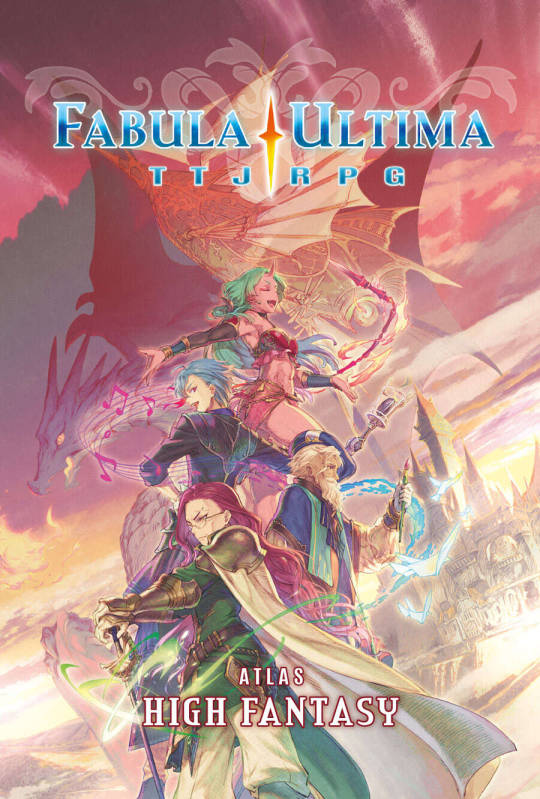
What do you get in the High Fantasy Atlas? Well you'll find the following:
Chapter 1 - Introduction: This section covers how the pillars of JRPGs work in High Fantasy games and offers more details and examples on how to implement them. Very useful for session 0 world design.
Chapter 2 - The World: This introduces 10 sample high fantasy locations you're likely to explore in a high fantasy world of Fabula Ultima game along with advice for creating new Arcanum for the Arcanist class, details concerning the creation of gods and demons, how the Stream of Souls functions, and info on tech and magic. The latter part of the chapter has new rare item rewards and artifacts you can give players!
Chapter 3 - Protagonists: This chapter includes sample PC ideas with info on them along with the new custom weapon, quirk, and zero power optional rules. The latter part of the chapter includes 4 new classes, the chanter, commander, dancer, and symbolist, along with heroic skills for classes new and old.
Chapter 4 - Antagonists: The first part of this chapter explores how to use antagonists in High Fantasy games while the latter half offers 5 villains from levels 10 - 60 you can use in your game or as a jumping off point to make your own!
Overall, 200 pages of content useful for not just High Fantasy games, but any really! Let's go over some of my favorite bits in each chapter.
Chapter 1: Introduction
This chapter, though the shortest, is incredibly helpful. Having examples and additional explanation for how to implement the pillars is useful for groups, especially those coming from systems like D&D and Pathfinder who might not be used to having such power to shape the world. Otherwise, it offers a solid introduction to the genre as well.
Chapter 2: The World
By far the longest chapter, there's a few notable things that aid immensely, but let us begin with how the sample locations work.
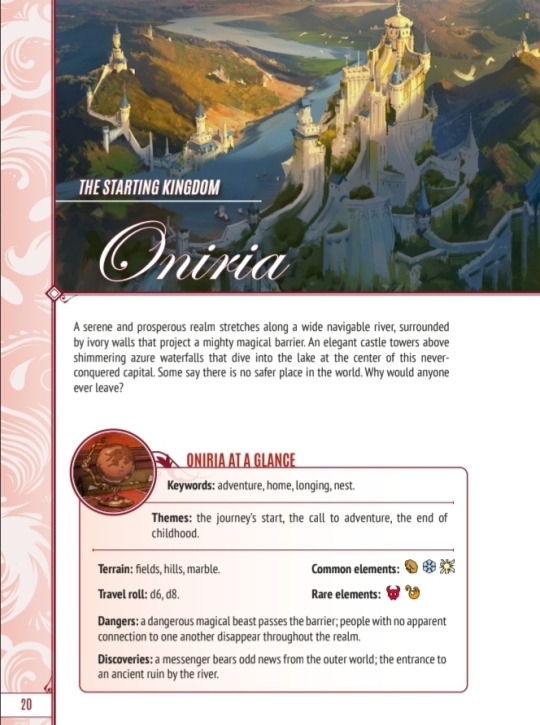
Each of the 10 locations starts off like this with an intro and an "at a glance" sidebar. This really helps you conceptualize what the area is supposed to invoke feelings wise and offers you nice reference for travel rolls and what kind of enemies and discoveries you may find here. I highly recommend doing this for locations in general your group makes, it helps a ton.
After this, each location has some example quests and questions to ask your players to flesh out this area and areas like it. Perfect for giving others the ability to add their own flair to the area and to get them started with playing when they enter the area. These story hooks also often have a villain described with tactics they use and any relevant clocks, but they have no stat blocks, so you can make them to fit with your group's playstyle for combats.
Afterward is a section on how to run conflicts and make them memorable, helpful if that is something you've been struggling with. It also has some nice ideas regarding how to run fights against armies, which is certain to come up here and there in games.
Lastly, we explore the magic and tech of High Fantasy. The advice for making new Arcanum, whether for world building themes or for the Revelation heroic skill, is greatly appreciated as it's one of the hardest things to balance and get right without a good understanding of the game. Advice on how the afterlife and Stream of Souls works thematically in your game is also useful and it offers some nice plot hooks you can use with the ideas presented I've put into practice even before the release of the Atlas to great effect. Lastly, the section on technology is short but appreciated, exploring how it differs from a Techno Fantasy game.
The new rare items are mostly geared towards enhancing specific skills for classes rather than general use, but it's handy for figuring out how to price similar items focused on certain skills when making your own. The new artifacts are also grandiose and powerful additions to any game, magnificent rewards if your party can acquire them. My favorite is a book that contains all knowledge up to the present moment in time, but was sealed away in the far reaches of space... supposedly.
Chapter 3: Protagonists
The main course! This has the 4 new classes and a bunch of optional rules we saw in the playtest. But, first I want to take a look at the sample PCs.
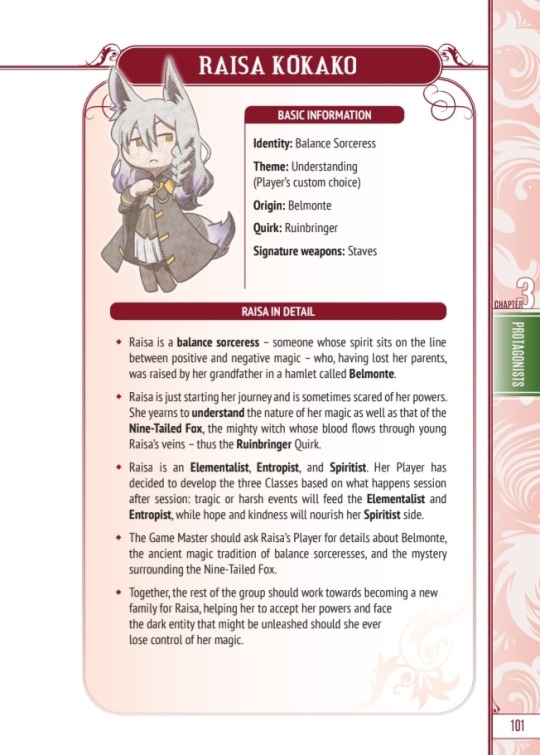
Each of the 10 sample PCs has a profile like such. It covers the usual Identity, Theme, and Origin, along with a Quirk and signature weapon. Quirks are a new rule that work as backgrounds, but suped up with powerful game changing and character altering effects ranging from gaining some spells to being able to choose to make costs for a spell or Ritual free at the cost of eventually summoning a supreme villain... that will come eventually whether you like it or not. Ones like those typically give you a free heroic skill when the big event comes and you lose the quirk. Preparing you to face a new horizon or final foe.
Back to Raisa however. As we can see here, it has info on her backstory, classes, what she gets to decide about world building wise, and how they'll grow in their own character arc. Useful for someone who wants to jump right in with a somewhat premade character, but even more useful for showing your players what you need to know about their characters if you're a GM. This should also help direct and inspire players during world creation. Which I greatly appreciate. Now, for the new optional rules (besides quirks).
Custom weapons are pretty simple. They're essentially weapons you design mechanically as a player. They're always two-handed, cost 300 - 400 zenit, can be any weapon type you want along with being melee or ranged, and deals [HR + 5] physical damage with a [DEX] + [INS/MIG] accuracy check depending on what you choose. You can then pick a few traits, like Powerful for extra damage, Defense Boost for extra armor and to make it count as a shield, or Transforming to let it switch between two different modes. Depending on what traits you pick, it may also become martial. This rule can be used by anyone who wants to use it without fuss unlike quirks and zero powers, as it adds no extra power and is fairly balanced. Some people could play with custom weapons, some without. But, it allows for you to add a lot of style to your character if you choose to do so.
Lastly, zero powers are a mechanic I've been using for half a year from the playtest and it's loads of fun! Want a limit break or perhaps combo attack in vein of Tales of Arise? Zero powers have you covered. When using this rule, you gain a 6 point clock that fills whenever taking damage, spending a Fabula Point to invoke a trait or bond, or via special Zero Trigger you pick when making your power. Then you pick an effect to go with the trigger you can unleash with an action when the clock is full, like Zero Limits which boosts all your stats by 1 die size or Zero Triangle to allow you and 2 allies to make a free attack with a +5 bonus to accuracy. Zero Powers are loads of fun and you can even allow for players to charge them up together for combo attacks with a variant rule for 4 or less player parties.

Welcome to the show! The Chanter is your premier bard. Chanter's main skill is Magichant, which allows them to sing or play songs you compose yourself by picking a volume (to determine number of targets), key (to determine damage types, attribute, status effect, HP/MP), and tone (to determine the effect with info filled in by your key). It's an amazing support class with high MP usage, but they can easily target enemy Vulnerabilities or act as a debuffer too to tear their foes apart. Their other skills allow them to perform hearing-based illusion Rituals, increase damage or regain MP when enemies are hit, give damage reduction to themselves, or get a free attack with low and medium volume magichants.
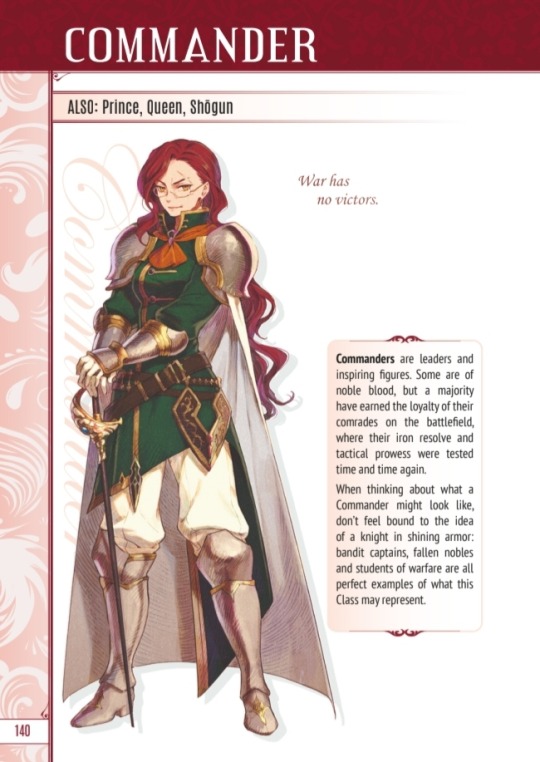
Being a chess master is the name of the game with Commander. Gaining access to martial weapons of all types, the Commander has skills focused on creating conflict scene wide buffs and debuffs to everyone. Use Bishop's Edict to double MP costs or increase all damage or King's Castle to increase HP/MP recovery or null it entirely. Their other skills allow them to command allies to make free attacks with handy bonuses and chain together their skills when doing so, leading to a flurry of activations. But be careful, one wrong move can lead to your downfall. Commander works best as a sort of Warlord class, they're a support martial pure and simple, but if the player using it isn't very smart about how they use their skills they can put everyone in a heap of trouble.

Swift of step, Dancer's main skill is well... Dance! Dance allows you to spend 10 MP before or after an action to perform a dance (5 MP if you used Dance last turn). Dances provide a variety of effects but most give you resistance to a damage type or allow you to alter all your damage to that type until the end of the turn or give the enemy a status condition, or another different one if they already have it. There's also healing and haste dances if you want those too! Their other skills allow them to apply dances to others they have affection towards, dance and use the equipment action for free, get bonuses towards rolls involving acrobatics for Objectives, or increase the damage of their weapons or spells after dancing. Dancer is primarily another support class, but their ability to change damage types and increase damage makes them amazing at targeting Vulnerabilities and denying enemies damage by gaining Resistance.
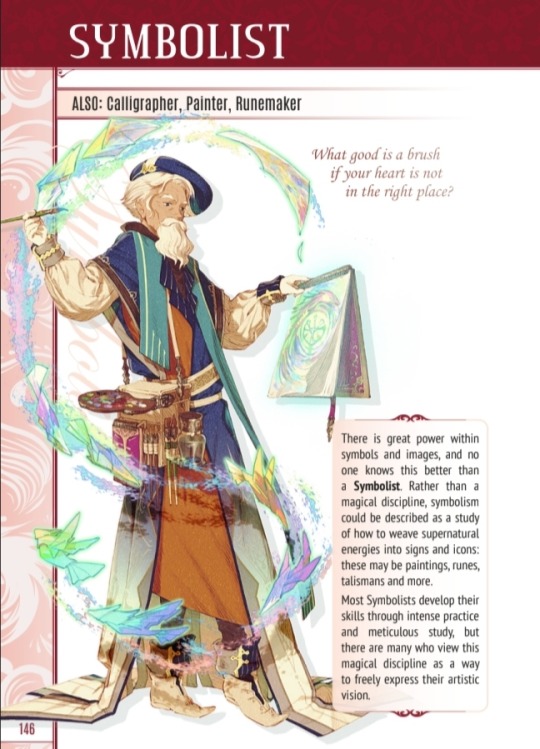
Symbolism has always been the heart of magic and the Symbolist knows this best. An IP focused class like Tinkerer, Symbolist's main skill is Symbolism. By spending 2 IP, you can create a symbol and attach it to an ally or make a free attack and apply it to every enemy you hit (amazing with multi). Symbols range in effect from halving recovery, providing one free IP expenditure, or even changing the creature type. Their other skills allow allies with a symbol cast your spells, make sight-based illusions with Rituals, track enemies with symbols, and increase damage or recovery on those with your symbols. The Symbolist, like the Tinkerer, is focused on IP usage and as such will need a class like Rogue, Merchant, or Wayfarer to help keep that up. However, symbols allow for a lot of strategy and creativity in character building that you can use to your benefit. Picking your symbols will be paramount to your build, so be smart about what you pick and smarter about who you apply them too. Sharpshooter and Weaponmaster are also great picks if you intend to apply symbols to enemies.
Lastly, the new heroic skills are all solid. Most focus on using specific types of weapons, now rewarding you for sticking to them as your signature weapon. There's even a few only available to level 30 and higher, notably, Bimagus, which let's you dualcast spells and Grand Summon, which allows you summon Arcanum as separate entities to help you rather than merging.
Chapter 4: Antagonists
Compared to the last two chapters, there's less to say here but there is some great content. This chapter includes 5 villains of levels 10, 20, 30, 40, and 60 that make for fun inclusions in any High Fantasy game. The villains range from a pirate queen to the incarnation of narrative tragedy itself and each comes with a statblock, minions (if they have any), and advice on how to run their encounters. Some even have multiple phases, which is a great example of how to build your own multi-phase boss fights, after all... this isn't even their final form!
One thing to remember when using these enemies (and the book points this out thankfully) is that Fabula Ultima is designed in a way where you, the GM, have to make monsters your party can reflect upon and has the tools to fight effectively. So, when using these, change up the affinities, give them a makeover to connect to the heroes if needed, and use them as you see fit!
Final Thoughts
If you have been loving Fabula Ultima, pick up this book. There's so much great advice for running games and new content for players and GMs alike. You won't be disappointed! There's also some more beautiful JRPG style art within just like the Core Rulebook. If you enjoyed Bravely Default, FFIV, FFIX, FFX, or Tales of Arise, this book will let you live out the same fantasies and journeys featured in those games and gives you even more tools to be your very own heroes of High Fantasy and challenge tragedy itself on the Final Days.
You can purchase it on DriveThruRPG for $14 USD ($20 CDN).
54 notes
·
View notes